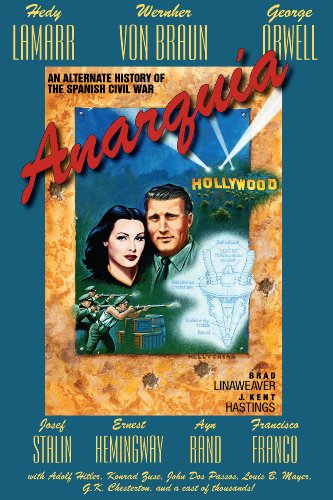L. Neil Smith's THE LIBERTARIAN ENTERPRISE
Number 884, August 7, 2016
are part of the “old boys club.” They talk
big, but they won‘t change a thing.
E-Book Round Up: Anarquia
by Sean Gangol
[email protected]
Special to L. Neil Smith's The Libertarian Enterprise
Anarquia: An Alternate History of the Spanish Civil War by Brad Linaweaver and J. Kent Hastings, is one of the first books that I read on my Kindle Fire, since most of the E-Books that I read prior were either on my Nook or on the Kindle PC format. What attracted me to this book was Brad Linaweaver, the creator of the web series, “Silicone Assassin” and the author of the most excellent novel, The Moon is Ice an alternative history novel of World War II that has a major libertarian twist to it.
Once again Linaweaver, along with his co-author Hastings, treats us to another form of alternative history that also has a strong libertarian bent. This time the story takes place in the 1930’s during the Spanish Civil War. While I was a history major in college, I have to admit that my knowledge of Spain’s civil war was somewhat limited, so this book was not only entertaining, but informative as well.
One of the book’s strongest points was the way it combined a series of historical figures that actually existed with fictional characters and had them meet in a single conflict. There were historical figures such as George Orwell, Ernest Hemmingway, Austrian actress Hedy Lamarr and Wernher von Braun, a brilliant German rocket theoretician and designer. Von Braun worked for the Germans before and during the Second World War and later for America’s space program. In the book’s timeline Braun as a kid inadvertently kills a matron while setting off a firecracker-rocket propelled wagon through the streets of Berlin. This little twist of fate actually leads him to Spain instead Germany.
For those of you who are unfamiliar with the history of the Spanish Civil War, there were several factions fighting for control of the country. One of them was the Republicans, an international voluntary force many of which had Marxist leanings. Then you had an anarchist faction that not only wanted to do away with government, but capitalism as well. Then you had the Nationalist group, which consisted of right-wing fascists. The book contains a glossary and a timeline that helps make these things clearer.
What I really found interesting about the book is the way that it compares the anarchist groups in Spain with American Agorists. I remember writing an essay on the “Anarchists” for my 19th Century European History class in college. In this novel we have the European Anarchists who are so collective in their beliefs that they seem to have more in common with the beliefs of communists. Then we have the Agorists, which didn’t actually exist in the 1930’s, but in this timeline they come to help their anarchist brethren in Spain. They differ from the European anarchists because of their libertarian views on private property and individualism. When I did my paper on the European anarchists, I thought that I would start off somewhat sympathetic towards the group in the same vain as I was to the Anarcho-Capitalist element of the libertarian movement. Aside from the fact that this group had a habit of showing a reckless disregard for the lives of noncombatants by using modern day terrorist tactics, their entire ideology made little sense. It seems like they wanted a world without government, yet they still wanted free healthcare and free public schooling (figure that one out). Then they also had the communistic belief that all property should remain communal, which is something that I can’t comprehend because in libertarianism, we consider private property to be the hallmark of liberty. Say what you will about Anarcho-Capitalists, but at least their beliefs are consistent.
The one fault to the book is that it ended a little abruptly. It was later explained at the end of the book that it was being left open for a sequel. The book was published in 2004 and we are currently in year of 2016. I still hope to see a sequel someday because it is too good of a story to give up on.

Anarquía: An Alternate History of the Spanish Civil War
by Brad Linaweaver and J. Kent Hastings
Illustrator, Kelly Freas
(Click on cover to buy from Amazon.com)
Was that worth reading?
Then why not:
Just click the red box (it's a button!) to pay the author
![]()
This site may receive compensation if a product is purchased
through one of our partner or affiliate referral links. You
already know that, of course, but this is part of the FTC Disclosure
Policy found here. (Warning: this is a 2,359,896-byte 53-page PDF file!)
TLE AFFILIATE
![]()

